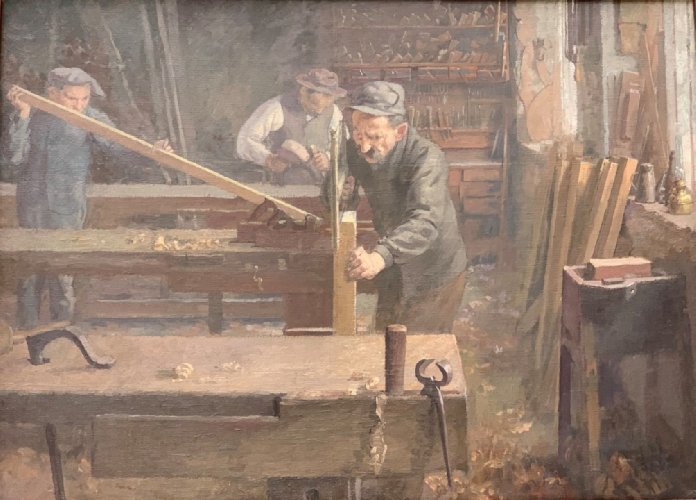Description:
François-Joseph Guiguet (1860-1937) was a French painter, draftsman and lithographer. He studied under the landscape painter August Ravier, then with Michael Dumas at the École des Beaux-Arts in Lyon, and later in Paris with Alexandre Cabanel, Puvis de Chavannes, Paul Gauguin and Edouard Degas, with whom he became friends. He exhibited at the Paris Salons for many years. He also often stayed in his hometown of Corbelin near Lyon, where he had a second studio. There he was inspired by the work of his father’s craftsmen in the carpentry workshop, which he often captured. In his work he dealt with naturalistic genre painting, then portraiture, for which he was famous. A characteristic of his works was the delicacy of expression and harmonious colouring.
Description of the painting:
The painting depicts a scene inside a carpentry shop. Three men are seen focused on their work at the woodworking. They are positioned at the long tables that protrude from the left edge of the canvas, each one at a table. In the foreground is the top of one of the tables, with shavings and tools visible. Through its placement close to the bottom of the canvas and its realistic portrayal, the viewer can almost feel as if they are in the workshop and observing the scene up close. Standing at one of the tables is a man cutting a rectangular block of wood with a hand saw. The worker is wearing a grey work shirt and a cap, his face showing concentration, wrinkles emphasising his age. His hand is also highlighted, clearly visible against the wood it holds. The man in the background is working on a board held at an angle on the table. He is placed at the left edge of the painting, his clothing in shades of grey. The third man is in the background at the third table, with a hammer and chisel in his hands. He is wearing a white shirt and grey waistcoat, his figure less distinct. To balance the horizontal lines of the tables in the left side of the painting, the right side shows a small table with high legs, and boards propped against the windowsills. On the windowsills are jugs of various shapes. Behind the men is a shelf detailed with woodworking tools and implements.
The composition of the work is based on interwoven horizontal and vertical lines, which create both workbenches, figures, but also pieces of wood or small containers on the windowsill. It gives rhythm to the work and creates an impression of order prevailing in it. In addition to rendering the scene, the artist also focuses on capturing the play of light coming through the windows on the right edge of the painting. You can see how it falls on the moldings resting on the windowsill, illuminates the shelf with tools or brightens the face of the man in the foreground, leaving the upper left corner of the painting in the half-dark. The work is kept in almost monochromatic range of colors made of browns and grays. The painting is a study of work in a carpentry. The artist accurately conveys tools and carpenters’ figures, but also skillfully creates an atmosphere of concentration and work prevailing in the workshop.


